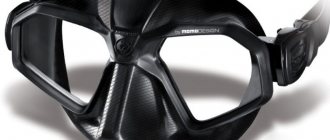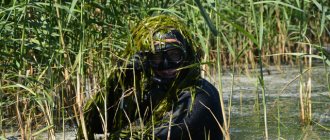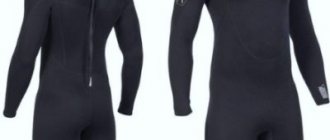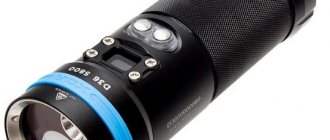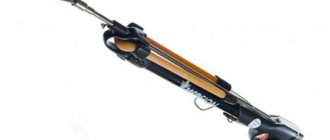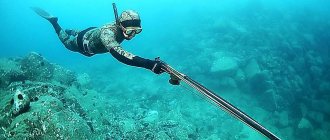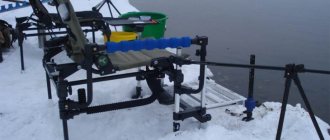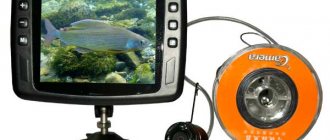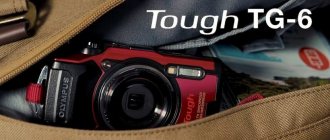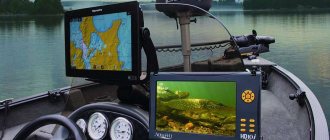Spearfishing – popular entertainment, exciting hobby, sport, excitement, drive. Finding prey, tracking it, and shooting accurately is not easy. Movements should be smooth and silent.
You experience the pleasure of spearfishing to the fullest when you find yourself in the underwater world, contemplate the beauty, colors, feel the instinct of a hunter, and get a trophy.
Required equipment and its description
Mask
Without a good mask, spearfishing will not work, it will be difficult for you to see the target and then hit it.
A high-quality mask for underwater hunting should fit tightly, but not squeeze your head. If the mask is not fitted correctly, you will feel a headache from the compression. The mask should be checked this way: place it on your face and suck in air through your nose.
It should stick and last for a while. We take into account the review of the mask - as much as possible. The black color of the silicone will protect from sun glare.
A tube
It’s also unthinkable to fully hunt without a snorkel; you won’t be able to stay underwater for long without breathing.
A beginner can get by at first with a not very expensive model, including one for diving. You should not use a tube with silicone corrugation, as it will make noise, which will scare the fish. A good solution is a corrugated, flexible tube on top and a flat, smooth surface on the inside.
The smooth surface will allow water to escape, which will prevent noise, and the corrugation will provide flexibility, which will prevent injury to the mouth from the mouthpiece. The option with an existing top valve is welcome. The top valve will suit any design.
Flippers
Fins serve as the swimmer’s “motor”; being in the water, equipped with weights and weapons, it is not easy to move quickly. The choice of fins is determined by the hunting location, factors such as diving depth and openness of the area are taken into account. Fins for hunting vary in blade size and material.
The galoshes are usually rubber, the blades are plastic or plastic. Stiffness also varies. Optimally, the fins are medium, not too hard, allowing you to maneuver in the water with penetration into thickets of plants. Long fins will make it difficult to move in shallow water with snags, and there is a risk of damaging your legs and fins.
Are you planning to hunt in deep water and in open space? You should choose long, hard fins. They will give you speed in deep sea diving. This option is more suitable for experienced hunters.
There are fins with replaceable blades. They suggest replacing the blade due to wear, breakage, or replacing it with a different shape. An excellent option for fins without a back. It is convenient that the foot fits in socks of different thicknesses.
After you purchase diving socks, when purchasing fins, you should try on this equipment together; as a rule, stores are equipped with showers for the convenience of customers. Properly purchased fins will successfully complement the catch equipment and improve maneuverability.
Gun
The type of place in which you intend to hunt will help determine whether you have a pneumatic or crossbow gun. If it is the sea, and also if it is not possible to swim close to the target, then a crossbow will do. An air gun will be indispensable in less transparent water, in thickets of reeds.
Costume
There are many options for a wetsuit for a comfortable dive. It is recommended to choose a suit consisting of a jacket and overalls. These items are sold separately, taking into account the discrepancy between the same jacket and pants sizes.
For summer, a suit with 5 mm neoprene is suitable, but a warmer version with a thickness of 7 mm is even warmer than 9 mm. In autumn and spring, the transparency of the water is greater, so hunting is the most exciting, therefore, the suit should be selected according to the external temperature.
The size of a wetsuit is considered appropriate if it does not compress the body and does not hang on the hunter. Often, stores offer to try on a suit directly at their place or with the option of returning it and trying it on at home in the shower. It is important not to make a mistake with the size, otherwise the hunter will freeze.
The most comfortable thickness of neoprene socks is 7 mm, 9 mm is also an excellent solution. Gloves come in five-fingered and three-fingered gloves; five-fingered ones are more comfortable, but they are thinner; in cold water the hands cool down faster.
The weight belt is selected taking into account body weight and the thickness of the wetsuit. It should merge with the body and not sag. The amount of weights can be adjusted. To prevent water from pushing out, a swimmer weighing 100 kg should be weighed by 10-12 kg, taking into account if his suit is 7 mm thick neoprene.
In order not to return to the shore or boat with a trophy every time, an underwater hunter needs a fish kukan. From a variety of options, this accessory can be selected as desired.
Knife
A very important thing in a hunter's equipment. If you forget your knife, the dive is cancelled. A knife is your safety in water. Main characteristics when choosing: reliability, functionality, convenience. It is better to attach it on the thigh.
You should consider a convenient fastening; in case of danger, the knife should be easily removed, the fastenings should not cling and interfere with movement.
Of course, this is not a mandatory list of equipment; each hunter individually selects hunting accessories for himself, according to weather and geographical conditions.
Gloves
Unlike a wetsuit, a gun and a mask, gloves are not considered an essential part of an underwater fisherman's equipment. Often experienced hunters cope without them. But gloves will prevent your hands from freezing after half an hour in cool water, and they will also protect you from injury from a snag, shell or hook. Moreover, after 20-30 minutes of immersion in water, the skin becomes tender - the likelihood of damage increases.
Usually gloves become unusable within one season. Of course, it all depends on your activity, regularity of hunting and luck - you can leave your gloves without a single cut for a very long time. Still, as in the case of hydrosocks, we do not recommend overpaying for them: pay attention to gloves from the middle or even budget price segment.
Gloves are not necessary in spearfishing, but for beginners they will help avoid injuring your hands on rocks or fins
Typically, spearfishing gloves are made from neoprene. Moreover, this material is used for both the inner and outer surfaces of the glove. Variations may be different, because the manufacturer faces a difficult task: the glove should not be too hard, so as not to hamper movement and not impair blood flow, but also not be too soft, so as to prevent damage after every second contact with an underwater object. Try to find a middle ground.
In winter, the issue of finger mobility fades into the background, because the main thing is to protect yourself from the cold. For this season, thick, 7 mm three-fingered gloves are chosen. They resemble mittens, where a dedicated compartment is provided only for the thumb and index finger. The latter is for the convenience of pressing the trigger of the gun.
Equipment requirements
Amateurs and professionals of this extreme sport clearly state that the requirements for equipment for spearfishing are the highest.
Gloves, socks, and a wetsuit must fit properly and be tight enough not to squeeze.
They must be waterproof and maintain a comfortable temperature. The mask is selected individually for each person; it must be made of high-quality materials, fit tightly to the face, and not allow water to pass through.
Fins are selected according to the size of the foot plus the toe.
The weapon is selected according to the hunter's hand. The length, power, and features of the reservoir where hunting is expected are taken into account.
It is not necessary to buy branded and expensive underwater equipment; it is important that it is practical and fulfills its characteristics one hundred percent. Accordingly, we must take into account that high-quality equipment is not cheap. You should not skimp on your own safety.
Additional equipment
Of the additional equipment for underwater fishing, a novice underwater hunter cannot do without:
- Kukan - necessary for preserving and transporting shot fish. This device is a strong cord with a wire loop. The kukan is usually attached to a buoy; installing it on the fisherman’s body greatly restricts movement and interferes with hunting, especially in cases where a large fish is shot. The kukan consists of a main line, a needle receiver and a system of carabiners. A fish for landing on a kukan is pierced with a needle in the area of the head, usually behind the lower jaw or gills and, fixed in this position, is left attached to the buoy.
- Buoy - serves to warn ship drivers that there is a person under water in this place. A kukan with fish, an additional underwater gun or a supply of drinking water is attached to the buoy. Beginning underwater hunters cannot always calculate their strength and swim for fishing very far from the shore; they can rest for a while by climbing onto a buoy.
- Knife - both novice underwater hunters and experienced scuba divers cannot do without this piece of underwater equipment. A hunting knife is needed at the moment when large prey is shot and until its motor centers are hit with the knife, the fish will make powerful jerks, which can cause the hunter to be wounded or the prey to fall off the harpoon. If a hunter gets tangled in fishing nets, snags on snags or underwater plants, then a knife will save his life. Therefore, it is not recommended to dive for spearfishing without this part. Choosing a good diving knife is not difficult at all. A high-quality tool should have a massive handle that will allow you to securely hold the knife in a diving glove. On one side, the knife blade should have a saw-tooth cut, which will allow you to easily cut even thick ropes and fishing line if necessary. The sheath must be securely attached to the equipment in such a place that it is convenient to get the knife at any time during the hunt.
Spearfishing spots
To practice spearfishing, you need a body of water with sufficient transparency.
When examining a reservoir for transparency, it is worth checking areas in different places. Somewhere it is windy, the water is agitated, and therefore muddy.
Somewhere it was quiet, calm, the water cleared after passing through the thickets of algae, the turbidity lay on the bottom. Usually, where there are areas with reeds, the water there is cleaner than in open areas of the river.
Many people prefer to hunt at night; the light of a flashlight provides a good overview. Many fish species are easier to shoot at night.
Where to start?
It is important to broaden your horizons in the field of spearfishing: read articles on relevant topics, watch video tutorials, communicate on forums. Equipment is purchased individually, but it is advisable to study the general characteristics in advance and think about what you need specifically.
It’s definitely worth practicing breathing techniques underwater through a snorkel; a swimming pool is perfect for this in the winter.
Basic Rules:
- It is not allowed to catch prey in wintering pits and on navigable fairways, as well as near dams, locks at a distance of at least 500 meters, and near waste collectors within a radius of about 500 meters.
- It is not allowed to mine in the area where fishing is carried out without approval.
- Hunting during the spawning period entails penalties.
- Hunting in public recreation areas is prohibited.
- It is not allowed to hunt with scuba gear or other breathing apparatus.
- It is prohibited to use spear guns on land.
- If you are in close proximity to people, it is prohibited to fire a gun.
Rules
In spearfishing, there are inherent safety rules that should not be neglected:
- The time spent under water should be monitored.
- Pay attention to the presence of boats, scooters and other technical means of navigation on the surface of the water, so as not to get hit.
- Do not unload the gun outside the water.
- Do not swim immediately to a large fish that has been shot.
- Do not transfer weapons to people who do not have sufficient skills to handle them safely.
- Do not dive to great depths if you lack experience and confidence in your own abilities.
- Never dive while exhaling;
- Avoid hunting in areas with significant underwater vegetation or debris - this can lead to loss of orientation.
To increase hunting efficiency:
- During dives, your legs should be bent at the knees. After diving head down, your legs should be sharply straightened, which facilitates rapid penetration into the depths.
- You should approach the fish in a horizontal body position.
- The head and sides of the fish are the most vulnerable and provide immediate immobilization places for shooting.
- For novice hunters, the recommended diving depth is 7-8 meters.
- An effective catch depends on the hunter making a careful, silent and smooth movement.
- You can swim closer to the fish while it is feeding.
- Swim up to the fish a little higher or lower than its location - this way the hunter’s perception will be minimal;
- The most effective way to hunt is in clearings that exist in dense aquatic vegetation;
- Morning is the best time to organize spearfishing.
Actions in extreme situations:
- If caught in fishing nets, it is not recommended to make sudden movements, which may cause more entanglement. In this case, you need to use a knife;
- If a cramp occurs, it is recommended to lie on your back. For at least 2 minutes, you need to massage the painful area with your hands and, if possible, use even and smooth movements towards the coastal side.
- In the case of a gunshot wound, the first thing to try is the level of penetration of the arrow. If the damage is superficial, it can be removed with care. The wound site should be treated with an antiseptic, apply a sterile bandage, and then consult a doctor. In case of serious injury, seek medical attention immediately.
- In case of loss of consciousness, the victim must be taken to land, placed on his back, head thrown back, and freed from restraining clothing. Try to revive it with ammonia or vinegar. Check the oral cavity and nasal passages for the possibility of free breathing. If necessary, perform artificial respiration and chest compressions. Contact a doctor.
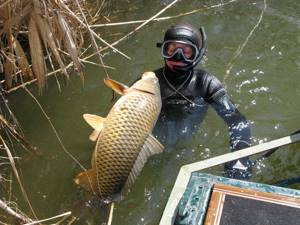
Safety precautions
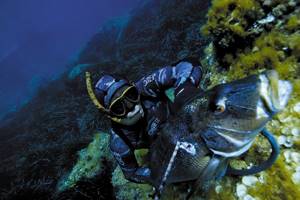
Remember that in a critical situation under water, even with a small supply of air and time, there is a way out.
If you are just thinking about taking up spearfishing, I would like to immediately point out that not everyone who can swim can do this. It is necessary to master the skills of swimming underwater with fins, a mask, and a breathing tube.
Improve the technique of involuntary breathing, as well as blowing out water poured into the tube during diving. It will take some practice before you can move silently underwater while spotting prey.
Peculiarities
Depending on the body of water and the season, spearfishing has its own characteristics:
- Freshwater bodies: here it is worth inspecting the edge of the vegetation by diving close to the bottom.
- Rivers: you need to move along the current.
- Seas: hunting is carried out closer to the bottom, with some kind of shelter nearby.
- Season: Seasons also affect spearfishing.
Winter time
- The fish is mostly passive, the reaction is calmer.
- The water is clear, which increases visibility and makes finding fish easier.
- Possibility of using long crossbows, the advantage of which is the production of silent, accurate and light shots
Flaws:
- Covering the surface of the water with ice.
- Descent of fish to significant depths.
- Possibility of hypothermia.
"Equipment":
- A wetsuit should be chosen with a thickness of more than 10 mm. At minimum water temperatures, it is recommended to use thermal underwear under the suit.
- The choice of gloves or mittens should be based on a thickness of at least 5 mm.
- As for socks, they should be centimeter thick.
- The load must not exceed 15 kg.
- To prevent freezing of the face, it is recommended to choose one-piece masks with open parts for the eyes, mouth and nose.
Spring time
- Spring spearfishing is short due to snow melt and prohibition due to fish spawning.
- Considering the low water temperature, a wetsuit of 10 mm thickness is selected. Arrows with hooking limbs or guns are used, the length of which should not exceed 50 cm. In general, the equipment should correspond to its winter counterpart.
- In reservoirs with standing water, spearfishing can be limited to a depth of 1.5 meters. As a rule, hunting is mainly carried out in a vertical position. Based on this, the blades of the fins should be of medium size.
Summer time
- Summer is considered the hot season for spearfishing. Places are selected where the level of visibility is the highest, and the depth varies from 2 to 4-5 meters.
- Given the warm water, there is no particular need for a wetsuit. You can dive into the water in a T-shirt and shorts. But, nevertheless, there are varieties of suits designed for summer. Suits made in a separate style are similar. Positive visibility allows the use of guns whose length can exceed 1 m in length.
Autumn time
Autumn is characterized by fish passivity and preparation for winter. Hunting is carried out at a depth of about 3 meters. The search for fish occurs among vegetation, among snags or in depressions.
Time of day: Most spearfishing is organized during the daytime. But there are also night types of spearfishing.
Positive features:
- High probability of catching large fish.
- There are no risk factors for collision with technical navigation equipment.
- Lack of cases to interfere with fishermen fishing with rods.
- At night there is no wind, which facilitates the close movement of fish to the coastal shallows.
- Possibility to use flashlights, making tracking and hunting easier.
Negative features:
- The flashlight occupies the free hand. A constantly outstretched arm gets tired and when making shots there may be misfires if you do not support the weapon with your second hand.
- Difficulty reproducing concentration on the target due to the monotonous water background, difficult separation of fish from vegetation.
- The likelihood of entangling the ropes of the kukan, the lantern and the fish itself.
- Orientation difficulties, as a result of which there is a possibility of becoming entangled in nets, falling into underwater rubble, or ending up in the branches of flooded trees
- The equipment is “on duty”, as in all cases. But the most important things are the presence of a flashlight and a knife.
